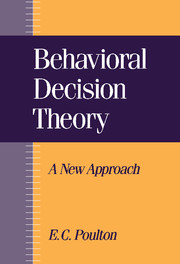Book contents
- Frontmatter
- Acknowledgments
- Contents
- Preface
- Chapter 1 Outline of heuristics and biases
- Chapter 2 Practical techniques
- Chapter 3 Apparent overconfidence
- Chapter 4 Hindsight bias
- Chapter 5 Small sample fallacy
- Chapter 6 Conjunction fallacy
- Chapter 7 Regression fallacy
- Chapter 8 Base rate neglect
- Chapter 9 Availability and simulation fallacies
- Chapter 10 Anchoring and adjustment biases
- Chapter 11 Expected utility fallacy
- Chapter 12 Bias by frames
- Chapter 13 Simple biases accompanying complex biases
- Chapter 14 Problem questions
- Chapter 15 Training
- Chapter 16 Overview
- References
- Index
Chapter 1 - Outline of heuristics and biases
Published online by Cambridge University Press: 06 July 2010
- Frontmatter
- Acknowledgments
- Contents
- Preface
- Chapter 1 Outline of heuristics and biases
- Chapter 2 Practical techniques
- Chapter 3 Apparent overconfidence
- Chapter 4 Hindsight bias
- Chapter 5 Small sample fallacy
- Chapter 6 Conjunction fallacy
- Chapter 7 Regression fallacy
- Chapter 8 Base rate neglect
- Chapter 9 Availability and simulation fallacies
- Chapter 10 Anchoring and adjustment biases
- Chapter 11 Expected utility fallacy
- Chapter 12 Bias by frames
- Chapter 13 Simple biases accompanying complex biases
- Chapter 14 Problem questions
- Chapter 15 Training
- Chapter 16 Overview
- References
- Index
Summary
Summary
Probabilities differ from numbers in that they have a limited range of from 0.0 through 1.0. Probability theory and statistics were developed between World Wars I and II in order to model events in the outside world. More recently, the models have been used to describe the way people think, or ought to think. Both frequentists and some subjectivists argue that the average degree of confidence in single events is not comparable to the average judged frequency of events in a long run. The discrepancies between the 2 measures can be ascribed to biases in the different ways of responding.
Tversky and Kahneman, and their likeminded colleagues, describe a number of what can be called heuristic or complex biases that influence the way people deal with probabilities: apparent overconfidence, hindsight bias, the small sample fallacy, the conjunction fallacy, the regression fallacy, base rate neglect, the availability and simulation fallacies, the anchoring and adjustment biases, the expected utility fallacy, and bias by frames. Each complex bias can be described by a heuristic or rule of thumb that can be said to be used instead of the appropriate normative rule. Some version of the heuristic of representativeness is used most frequently.
- Type
- Chapter
- Information
- Behavioral Decision TheoryA New Approach, pp. 1 - 16Publisher: Cambridge University PressPrint publication year: 1994



